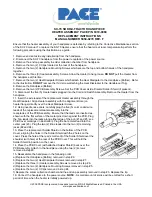
944050 Needle Torque Wrench
- Allows the torque applied to a fas-
tener to be measured accurately, thus avoid damaging components
or fasteners. Unlike micrometer torque wrenches (sometimes known
as click-type), which fatigue and sometimes wear, beam torque
wrenches do not require periodic calibration and adjustment. This
wrench's compact head accepts 1/2" sockets or extensions. The
palm-fit handle pivots on the beam to maintain a constant distance
from drive point to load point for precise measurement of torque val-
ues up to 150 ft. lbs. (203 N.m).
WARNING!
•
DO NOT
STRIKE THE TORQUE WRENCH OR USE IT AS A
HAMMER OR PRY BAR.
•
DO NOT
STORE THE TORQUE WRENCH IN A PLACE WHERE
THE POINTER COULD BE DAMAGED.
•
DO NOT
DROP THE TORQUE WRENCH. DAMAGE CAN OCCUR
TO THE POINTER OR BEAM.
OPERATING INSTRUCTIONS:
1. Before using, make sure the pointer lines up with the "0" (zero) on
the indicator scale as shown in Figure 1. If the pointer is bent, it
should be bent back to the center ("0").
2. Install the proper socket into the square drive. Place the socket
over the nut or bolt to be tightened.
3. Grasp the pivoting plastic handle and apply force to the center of
the plastic handle. Pull the wrench by this handle ONLY. Make sure
that the plastic handle remains centered on the pivot. DO NOT let
the handle tilt and contact the beam at either end of the handle.
4. The force applied will cause the beam to bend. The pointer will
remain straight while the indicator scale moves under and in rela-
tion to the end of the pointer.
5. When the pointer lines up directly with the desired torque specifi-
cation, release the applied force and remove the socket from the
bolt or nut.
6. Do not continue to apply force once the desired specification is
reached. To do so will result in an over-tightened fastener. Over-
tightening a fastener may cause it to break or the threads to strip.
7. The final torque reading should be made while the fastener is still
being turned.
NOTE:
If you hear squealing or cracking noises from the fastener, it
may be seizing. Remove the bolt or nut and check the threads. Clean if
necessary. Fasteners should be free of all dirt and rust. DO NOT lubri-
cate threads as this will lead to incorrect torque measurements.
MAINTENANCE:
1. If the pointer is bent, it should be bent back to the center ("0"). This
will not damage the pointer and the wrench will retain its accuracy.
If the beam is bent, the wrench should be removed from service.
2. When the wrench is in use, the pointer should not touch or scrape
on the indicator scale or the metal cage that surrounds the pointer
needle. If the pointer does scrape, bend the plastic tip up or down
slightly so that the pointer remains centered inside the metal cage.
























